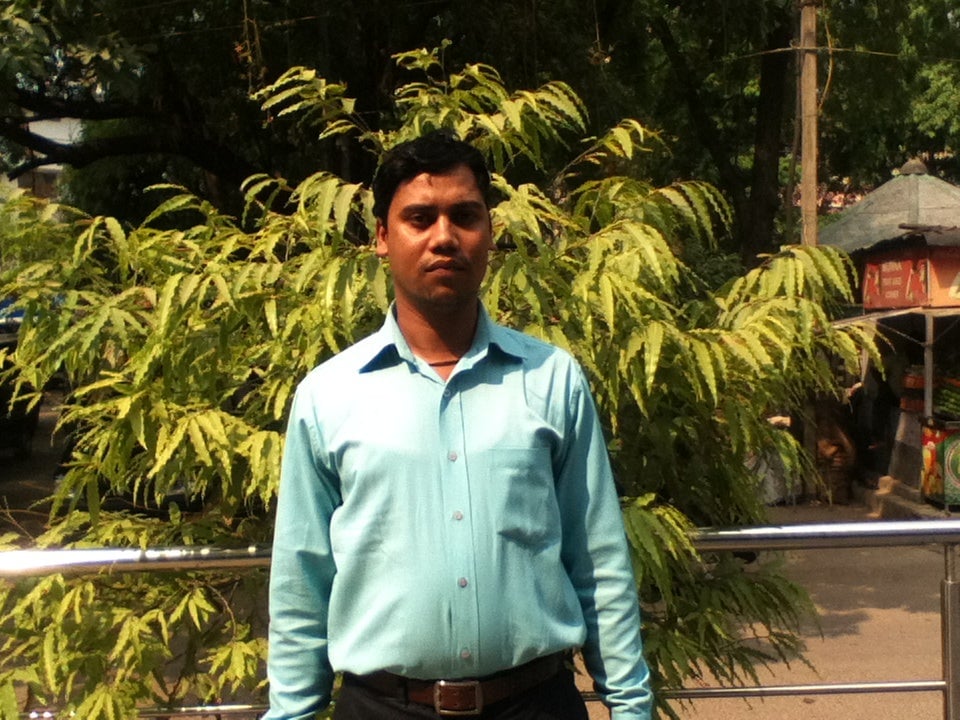Roaming 100 km a day, a young man survives by selling yoga to middle-class India
This post has been corrected.


This post has been corrected.
Vinod Kumar will not be around at the high-powered celebrations for International Yoga Day in the heart of Delhi. June 21 will be like any other day for the 25-year-old yoga instructor to Delhi’s upper middle class. Kumar will wake up, as usual, at the first hint of dawn, and by 5 AM, probably before the 37,500 mats have been laid out along Rajpath, he’ll leave his one-room house in Noida to travel along the vast circumference of the National Capital Region, setting the bodies of people from 20 to 60 years of age into yoga poses best suited to their needs.
The multi-million-dollar celebrations on Rajpath is for high priests of the yoga world, Kumar told me. “Famous gurus, owners of big ashrams, people like that,” he said, sweating from his 14-kilometre motorcycle ride from Mayur Vihar, where he finished the last class of the day at 7:30 PM, to Jangpura through rush-hour traffic.
The idea of an International Yoga Day, to be celebrated by 192 countries in the world, does indeed seem more focused on creating a spectacle than anything else. In Delhi, the event’s arrangements will be at par with Republic Day. It’s a show of numbers meant to ensure no one in the world ever doubts India’s ambition again: 1,400-metre stretch of Rajpath, 37,000 participants, 50 nationalities, 3,000 district police personnel standing guard, 1,500 traffic policemen, 150 CCTV cameras, Rs100 crore publicity budget. No wonder the organisers are leaving gaps between rows of participants for observers from Guinness book world record to assess the scale of things.
Yoga was survival
Kumar is small fry in India’s suddenly exploding yoga market. Over the five years that he has been in the business, he told me, yoga has taken a big leap in Delhi’s middle-income life: “I would say, simply, that when I began, I had to explain to everyone what yoga is and what it does for you, and now I don’t need to explain any of that to anyone.”
The mainstreaming of the stretching routine once considered the preserve of the holy and the middle-aged means that India’s hordes of job-seeking young view it as opportunity. There are no official numbers for people involved in teaching of yoga in the country, but according to a news report, 500,000 yoga teachers work with the Patanjali group alone, run by celebrity yoga guru and spiritual leader Baba Ramdev.

Yoga was survival for Kumar. The only son of a small farmer in Banka district of Bihar, Kumar had spent the free time between his secondary school examinations and high school admission at the world-renowned Bihar School of Yoga with headquarters in Munger, a short bus ride from his village. “I had been attracted to yoga for as long as I can remember. The free one-month course at the Bihar School was as much yoga as it was about developing one’s personality,” said Kumar. He was the first person in his family to attend high school, a fact his parents took pride in, until they were down with a financial crisis and Kumar had to take to train to Delhi as a 20-year-old high-school-pass with a thousand rupees in his pocket.
“What can a young man do in Bihar, where they are no companies to employ us? Even those with postgraduate degrees in Bihar have to work in the fields. It’s a hopeless place. I like Delhi. The amazing thing about Delhi is that everyone finds something to do here,” Kumar said.
Starting up
Within days of arriving in Delhi in 2010, where he lived in Mehrauli with a friend from back home, Kumar realised he could turn his training in yoga into a way of employment. After getting a degree in teaching yoga from The National Institute of Open Schooling in the same year, he started assisting a trainer who ran classes in his neighbourhood. “The money was okay—Rs8,000 to Rs9,000 a month—but the person treated me very badly, so a few months later, I told him he could keep whatever money he owed me as salary and quit the job,” said Kumar.
He decided to work for himself. “I created pamphlets advertising my yoga classes and had those distributed with newspapers in the Noida area, where I had moved to by then. Work kept coming as one client recommended me to another.”
Kumar’s clients fall into two categories, according to him: young professionals (“media, lawyers, corporate people”) who keep moving in and out of the city and the “Delhi circuit”—families with a sizeable number of members or social connections. Not everyone he teaches yoga is in it for the same reason, he stresses; young people mostly do it to achieve fitness and the old to beat illness. Not all of them approach yoga with the same philosophy, either. It’s only people above the age of 40, he said, who care about knowing the mythology behind yoga. “I give to each what they want. For the cynical, if they are not comfortable with listening to a recording to “aum” while they do yoga, I ask them to play whatever music they like.”
Kumar isn’t overtly religious himself, he said, although he believes deeply in the existence of God. What he doesn’t get is the brouhaha over yoga’s appropriation by the Hindutva lobby: “Yoga doesn’t belong to any religion in particular. What people don’t understand is that yoga itself is a religion.”
A decent life but not forever
Five years after Kumar started his own yoga enterprise, he has made a life for himself in Delhi: a roster of clients (14 to 15 at a time when the going is good), a growing reputation, a house, a few friends, and a fathomable future. The money is not a lot (he doesn’t want to go into numbers) or even consistent (“it’s a constant hunt to replace clients dropping out or moving town, and there is practically no work for the entire winter, when people feel too lazy”), but he likes being his own master, especially the part about going off to the village for the winter and doing nothing for two months. He is proud of having managed to pay for the treatment for his sick grandfather and the wedding of his older sister with his income.
For all the certainties he has created for himself over the years, Kumar doesn’t think he could live this way forever. He’s aware of the damage driving a motorcycle for over a hundred kilometres every day can do to his back and shoulders over time. He’s also aware that he can’t go much further in this field without speaking English: “It’s only after coming to Delhi that I realised how important it is in order to do well at any job. I have friends who know English and teach yoga to the foreigners, who pay enough that they only have to work for two months in a year—they can rest for the remaining time.”
In the few hours he has to himself during the afternoons, therefore, Kumar goes through his options. He studies for annual examinations at a college he has remotely joined in Bhagalpur for a graduate degree in political science; he keeps track of job openings in the railway; he researches courses for becoming an electrician at industrial training institutes.
Irrespective of the direction his life would take over the coming years, Kumar said, yoga would remain crucial to it. There are few things more satisfying to him than configuring his body into his favourite asanas: Chakrasana, Sirshasana, Sarvangasana, mayurasana, hansasana. In his imagining of the future, yoga will have gone from being a lifestyle choice to a necessity for wellbeing: “It won’t be thinkable for anyone to not practice yoga.”
Correction: An earlier version of this post incorrectly stated that Kumar studied at The Indira Gandhi National Open University. He got his degree in teaching yoga from The National Institute of Open Schooling.
We welcome your comments at [email protected].